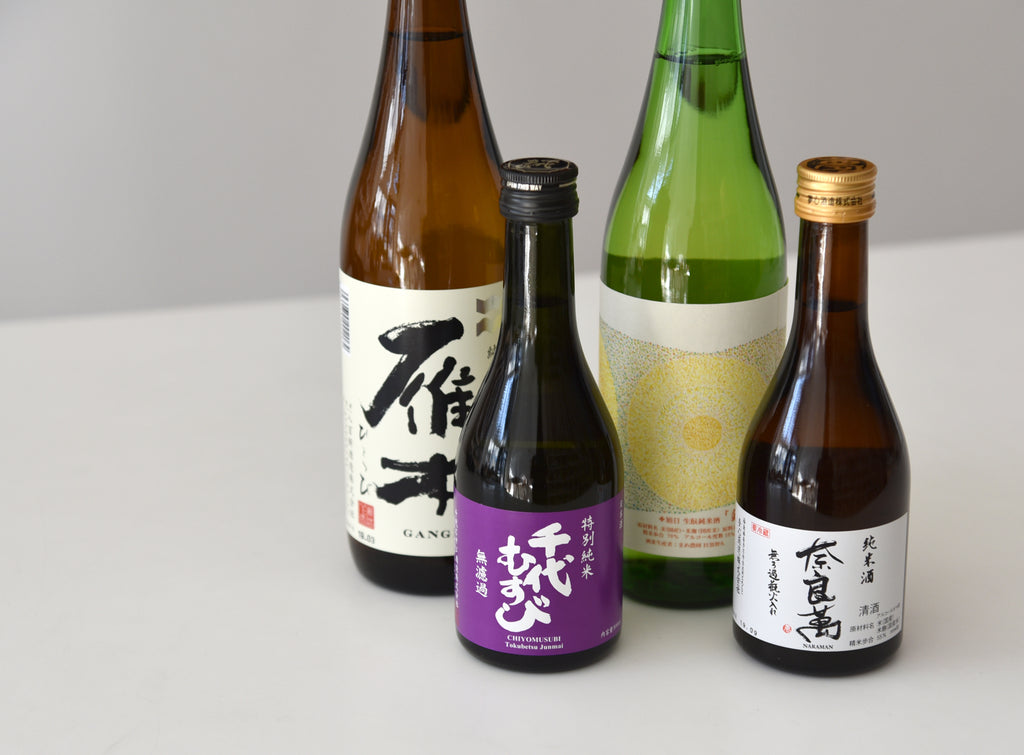 Why muroka? Some brewers say they want to preserve the characteristics of the water, while most said they are trying to brew a sake that has more koku (depth) and umami.
Why muroka? Some brewers say they want to preserve the characteristics of the water, while most said they are trying to brew a sake that has more koku (depth) and umami.
Sake Gumi is our monthly sake subscription service with 200 members throughout California. Join today!
Happy New Year, Sake Gumi members! In this brand new year and decade, we’ll have lots in store for Gumi members. We’ll be exploring new themes, hosting events at our bar, and Kayoko and I will be traveling to Japan to sniff out the best sakes! For the first event of this year, we’ll be welcoming Chiyomusubi Shuzo, whose tokubetsu junmai is featured in Level One this month. Join us Sunday January 26, 12-2pm for a special appearance by the brewer at the Umami Mart Bar.
Let’s not waste any precious time and get geeky right away in 2020. The theme this month is muroka. Muroka is comprised of the following kanji characters, 無 (mu): nothing; 濾過 (roka): filtering, referring to sakes that have not gone through charcoal filtering.
Wait, I thought nigoris were unfiltered? you may be thinking. Indeed, the translation for nigori (unfiltered) and muroka (un-charcoal filtered) is quite confusing. I prefer to describe nigori as lightly-pressed instead of unfiltered, since nigori refers to sake that still has some sake lees in it (because not all of the solids were squeezed out of the liquid during pressing). Whereas muroka refers to sakes that have not been charcoal filtered after maturation.
How do they charcoal filter, and why do they do it? After maturation, brewers typically mix powdered charcoal into the sake to absorb any impurities and rid the color of any yellow tinge (kind of like a Brita water filter). This practice is meant to remove any rough flavors and produce a clear sake that is more shelf stable. Producing a clear sake is important for perception, as often people identify yellow sake as old sake. To prove that the sake is not old, most brewers prefer to remove the color from sake.
So why skip charcoal filtration? I asked a few of the brewers why they chose to go au naturel with muroka. Some said they wanted to preserve the characteristics of the water, while most said they are trying to brew a sake that has more koku (depth) and umami. Although this is just a generalization, I have noticed murokas tend to be mineral-forward and rugged.
Charcoal filtering is a relatively new process - starting around 60 years ago. Like with any sake-making process, including it or skipping it doesn’t make a sake better or worse. Instead, it gives me insight into how the brewer made the sake and an opportunity to experience something different.
Kotoshimo yoroshiku onegaishimasu!
Yoko
Co-Founder + Sake Director
Umami Mart
LEVEL 1: Introductory Membership (Two 300ml bottles)
 Chiyomusubi Tokubetsu Junmai
Chiyomusubi Tokubetsu Junmai
Chiyomusubi Sake Brewery Co., Ltd. (Tottori, Japan)
Seimaibuai: Gohyakuman-goku 50%, SMV: +3
A real crowd pleaser, this sake starts with the pleasant taste of lychees, followed by a bit of juiciness, then leaves you with a clean, dry ending. The tropical notes performed very deliciously alongside a little spice – blistered shishito peppers were a great pairing! This sake is considered tokubetsu (special) because the brewer takes special care in limiting water absorption during washing, and uses a special blend of yeasts including one for daiginjo. Enjoy at room temperature.
 Naraman Muroka Bin Hiire Junmai
Naraman Muroka Bin Hiire Junmai
Yumegokoro Brewery (Fukushima, Japan)
Seimaibuai: 55%, SMV: +4
This rugged sake is a perfect example of a muroka. There’s a slightly milky, yeasty nose and a golden hue. Although this sake might taste a bit strong as a sipper, it’s a great sake for pairing with a hardy dish – we loved it with duck meatball nabe. Enjoy this structurally sturdy sake chilled, with its long finish and high ABV of 16%.
LEVEL 2: Premium Membership (Two 720ml bottles)
 Gangi Hitotsubi Junmai
Gangi Hitotsubi Junmai
Yaoshin Shuzo Co., Ltd. (Yamaguchi, Japan)
Seimaibuai: Yamada Nishiki 60%, SMV: +2, Yeast: #9 and 1801
Talk about au naturel - this brewery only makes muroka junmais. The brewer says, “We make a fully complete sake that requires no secondary processing after pressing. We approach the art of sake brewing simply, without the need to add or remove anything.” This genshu is surprisingly mild with slight minerality, best enjoyed at room temperature alongside sweet shellfish like crab and shrimp.
 Kagamigusa Junmai Kimoto
Kagamigusa Junmai Kimoto
Juji-Asahi Brewery Co., Ltd. (Shimane, Japan)
Seimaibuai: Omachi 70%, SMV: +13
Notice the label BY 27 on the bottle. This means that the bottling year was Heisei 27 (or 2015). Juji-Asahi Brewery believes that their sakes should be aged for some years before releasing them. Their high acidity sakes are unlike any other sakes I’ve tried before. This golden muroka sake reminds me of a cross between a Chablis and a tarusake (cedar-aged sake). There is so much going on in this bottle: yogurt, hinoki, parsley, passion fruit – I encourage you to ruminate on this one. Try chilled or at room temperature alongside smoked meats, fish, and cheeses.




Comments (1)
That is a good one!
Usually the best evenings are those ones spent in a bar with a chill drink and a piece of meat, chicken etc.
These days, camping and vacations are now made easy because of the presence of portable refrigerators that can help you chill your drinks and enjoy your ride…